Last updated on October 27, 2023
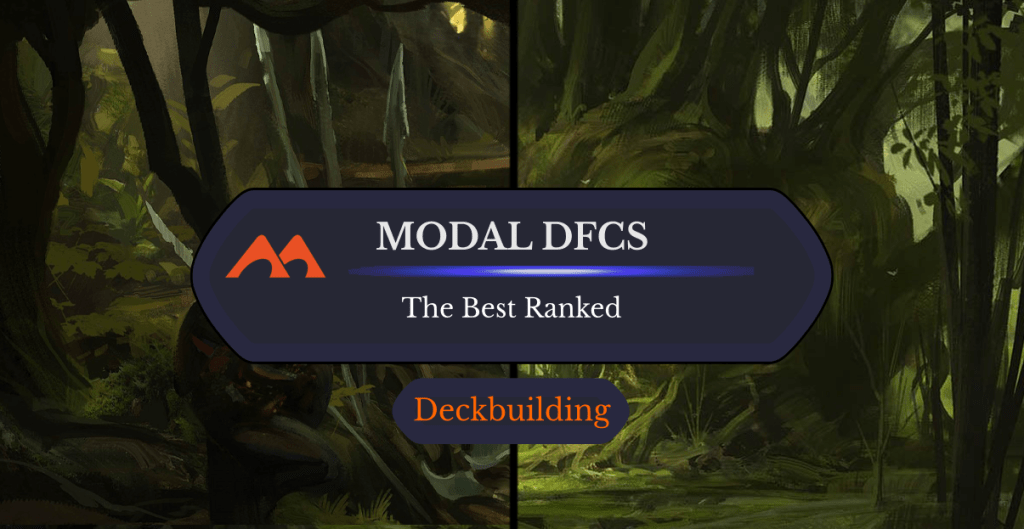
Bala Ged Recovery / Bala Ged Sanctuary | Illustrations by Lucas Staniec
Magic’s history is full of neat ways for one piece of paper to pack different punches. Werewolves are the most common transforming double-faced cards. Split cards like Catch // Release can be cast as either half or both combined. Charms are instant spells that allow you to choose between multiple effects.
MTG introduced a new type of card in 2021 going into Zendikar Rising Standard: MDFCs, or modal double-faced cards. Were these double-faced cards designed for double the fun, or double the complexity? Let's take a look and find out!
What Are MDFCs in MTG?
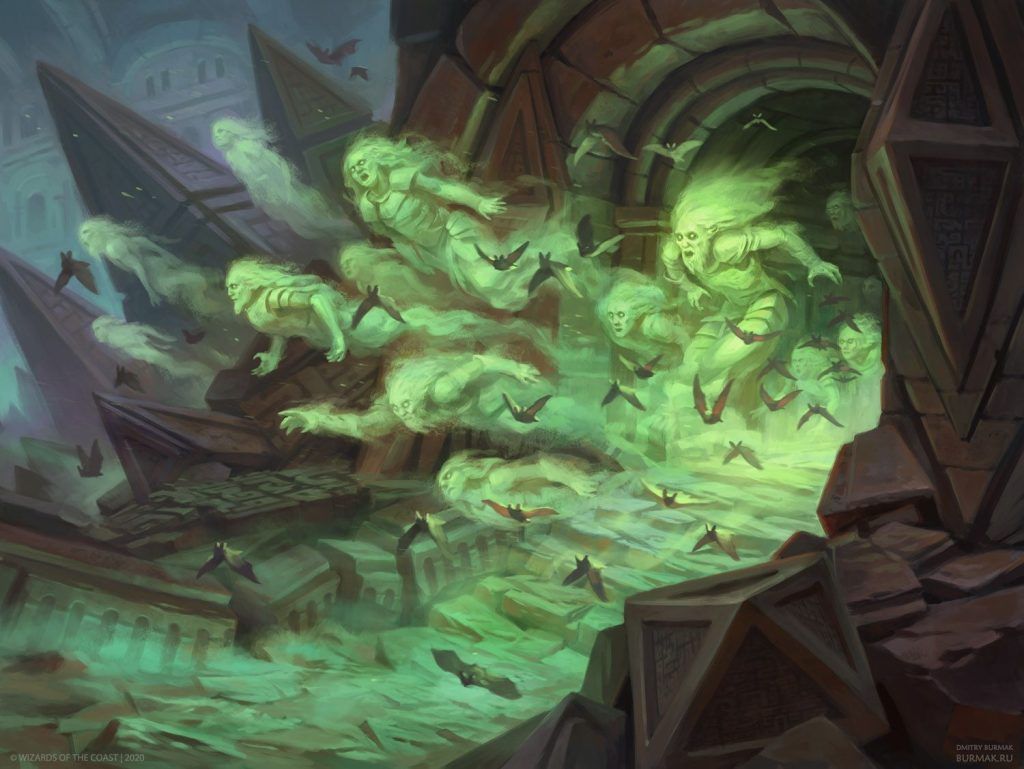
Agadeem's Awakening | Illustration by Dmitry Burmak
MDFCs, or modal double-faced cards, are Magic cards with two sides that can be played on either side of the card. Previous double-faced cards like those in the Innistrad sets can only be played on the front side, and then transform to the back side when specified conditions are met.
MDFCs were first introduced in Zendikar Rising and were used in the next two sets, Kaldheim and Strixhaven: School of Mages. According to Mark Rosewater, MDFCs were used to “tie together” the themes of the sets throughout that year.
There are lots of ways to make a good MDFC, like its power, flavor, or design.
(Dis)honorable Mention: Strixhaven Deans
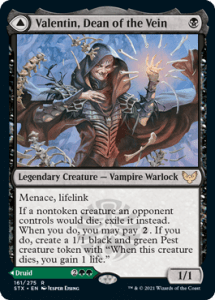
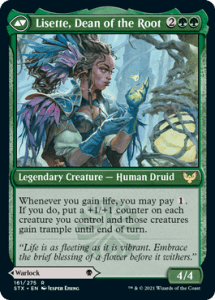


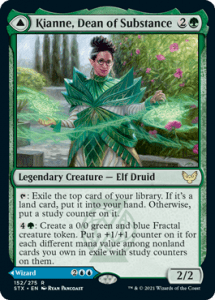
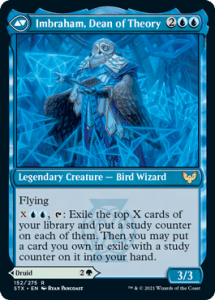
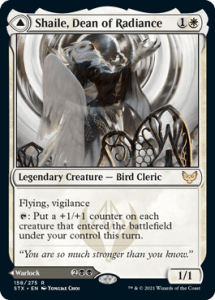
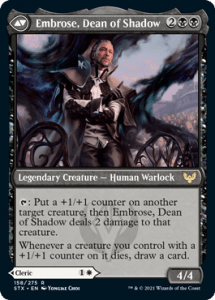
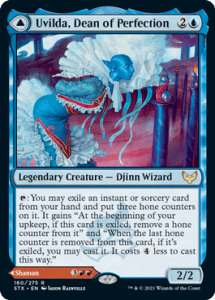
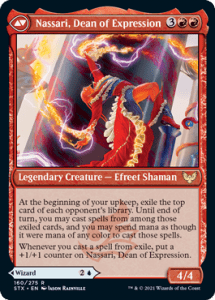
This might feel like cheating since I’m lumping a large chunk of these together. I frankly just don’t want to talk about these cards for very long. A lot of voices in the community have already complained about some of the design choices in Magic, like how a lot of the lore is lost in the sheer abundance that’s thrown at you in a short visit to a new plane.
This is true for the Kaldheim realms and for the Strixhaven deans. There are a few cool ones in the mix, but there’s also lots of forgettable dross. Can you tell the effects of one dean versus another based on names alone? I certainly can't!
#31. Augmenter Pugilist / Echoing Equation


Augmenter Pugilist and Echoing Equation make a Simic () card through and through. It’s a beefy trampler that cares about lands, and it has a cool, tricksy copying mode, too! Both sides of the MDFC work well together. Imagine turning an army of Saprolings into copies of Augmenter Pugilist with the back side of the card (outside of Commander, of course).
Even in Commander it’s nice to have the option of both modes. You might run it for the back side of the card more than the front in that format.
#30. Jadzi, Oracle of Arcavios / Journey to the Oracle
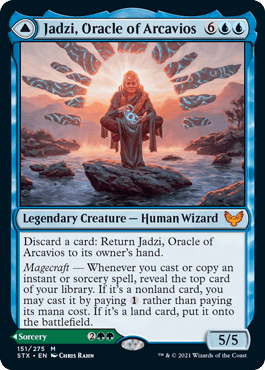

Another Simic Strixhaven card is Jadzi, Oracle of Arcavios. It’s undoubtedly a powerful card and one of the most played Strixhaven cards in Commander. But let’s be honest, it’s kinda just your typical Simic value engine!
A small difference is that this is a Simic card that cares about instants and sorceries. Imagine those turns when you can storm off the turn after you cast this, or even the turn that you cast it if you’re really doing the Simic thing and have oodles of mana.
#29. Mila, Crafty Companion / Lukka, Wayward Bonder
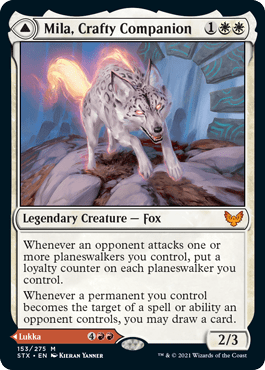
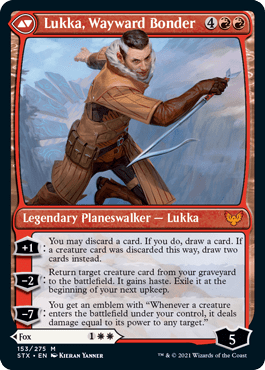
This is one of the more interesting MDFC designs just because it’s a planeswalker on one side. While that side is underwhelming, Mila, Crafty Companion has a unique ability that makes it interesting.
This card is probably only viable in a superfriends deck, but it’s nice to see card designers playing around with this space nonetheless.
#28. Rowan, Scholar of Sparks / Will, Scholar of Frost
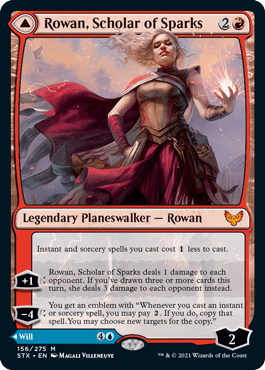
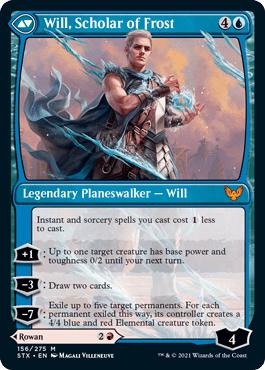
Speaking of planeswalkers, here’s another MDFC planeswalker. Rowan, Scholar of Sparks and Will, Scholar of Frost isn't just one planeswalker, but two! I think this is an amazing way to fit the lore considering Rowan and Will are twins.
At home in a spellslinger deck, both sides of this card can provide good value. The flexibility of being able to play on either side is a bonus. I don’t think either side of this would have raised too many eyebrows if it were printed as a single-sided card. Each side would be classed as one of the weaker planeswalkers alone.
#27. Egon, God of Death / Throne of Death
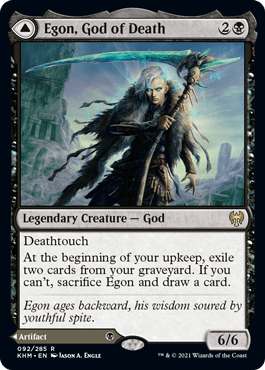

I think Egon, God of Death is an interesting card, but a little is difficult to make work. A 3-mana 6/6 is strong, though it comes with a dire downside as exiling two cards from your bin is a hefty cost.
The back side is a 1-mana artifact that mills you each turn and has another ability that lets you draw a card. This is exactly the kind of card that seems pretty inconspicuous right now, but a card will eventually be printed that Throne of Death absolutely breaks. I, for one, can’t wait to see it!
#26. Torrent Sculptor / Flamethrower Sonata
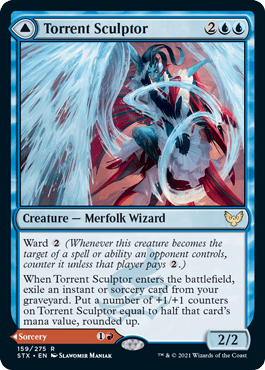
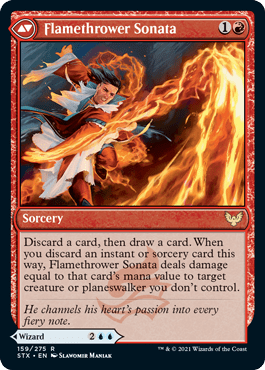
I’m not ashamed to say that I’ve bumped this up a place or two for the name Flamethrower Sonata alone.
It’s that side that props this up. A good early removal spell that doubles as a discard outlet is a pretty good rate, even at sorcery speed and with the restriction that you discard an instant or sorcery. I wouldn’t have been shocked to see this as a card by itself in the set, but probably at uncommon rather than rare.
Does it have another side? Torrent Sculptor is a perfectly fine card, too, I guess.
#25. Halvar, God of Battle / Sword of the Realms
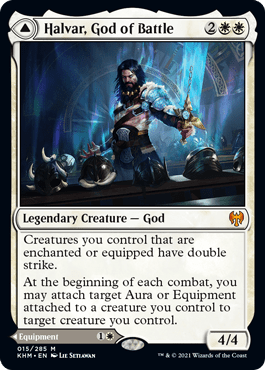
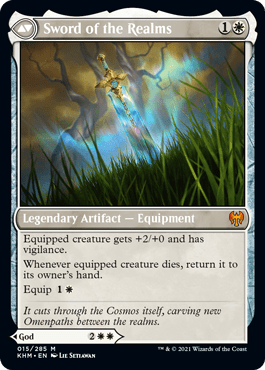
This came out when WotC seemed to be trying very hard to make equipment matters a thing (and kinda did, to be honest). Halvar, God of Battle is a beater for a good rate that can really shine in an equipment-focused deck.
One side has a 4/4 that gives out double strike like candy on Halloween, but Sword of the Realms on the back side is a strong equipment itself. Giving your beater extra power and vigilance can be a good way to quicken the clock in an aggro deck. Virtual protection for your creatures is a nice addition.
#24. Jorn, God of Winter / Kaldring, the Rimestaff

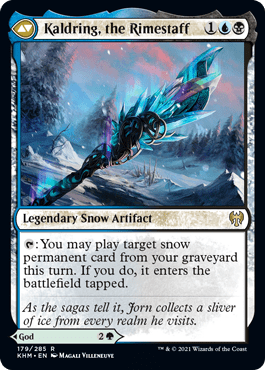
Kaldheim brought some MDFCs, but it also saw the return of snow spells. We’re now in the age of Commander, so there naturally had to be a snow-based commander, Jorn, God of Winter!
It gets points for being the snow commander, but Jorn is still a pretty cool card. Both sides can be useful without being busted. Using the two sides to give a wider color identity was also a nice touch here.
#23. Reidane, God of the Worthy / Valkmira, Protector’s Shield
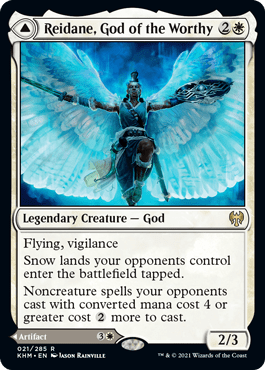
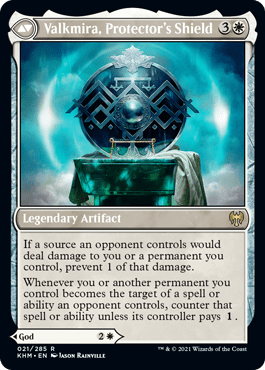
Speaking of snow, Reidane, God of the Worthy is pretty nice as one of the few pieces of snow hate. It doesn’t wreck snow decks, but it is annoying enough to have an effect. I’ve upset my own fair share of mono-black snow players in Standard with this beauty. A 3-mana 2/3 flier with vigilance can also put a surprisingly quick clock on your opponent.
The back side is also interesting. Valkmira, Protector's Shield lets you prevent one damage to anything you control, which can really upset combat math. It might even be worth playing just to see your opponents sweat when trying to figure out what to do when you double block!
#22. Kazandu Mammoth / Kazandu Valley

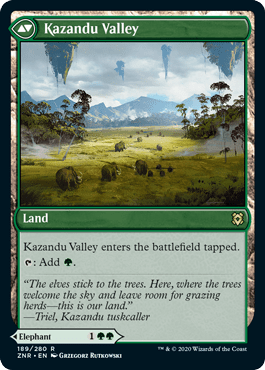
Cards ranked around here are generally good on one side with a second side that’s at least useable. It’s not surprising that a lot of the Zendikar Rising lands are here, either.
Kazandu Mammoth is a solid beater, often as a 5/5 for three mana. It could be even bigger in the right deck. Decks rarely want a tapped land in the early turns, but sometimes you just have to use it like that. You’ll be grateful that you can play it with this mode when you do.
This was a stalwart of Standard mono-green decks when it first came out, and it’s still a scary threat there as early as turn 2!
#21. Spikefield Hazard / Spikefield Cave
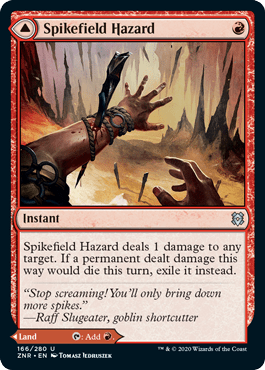
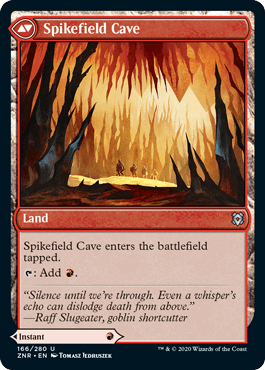
It’s always great to see commons and uncommons this high on a list like this, and Spikefield Hazard won’t be the last!
Dealing one damage may not seem like much, but a lot of formats are run 1-toughness creatures. Exiling whatever it kills (or whatever dies that turn) is useful in some metas. This isn’t seeing a huge amount of play in Pioneer right now, but I wouldn’t be surprised to see it sneak into sideboards in the future.
#20. Sejiri Shelter / Sejiri Glacier

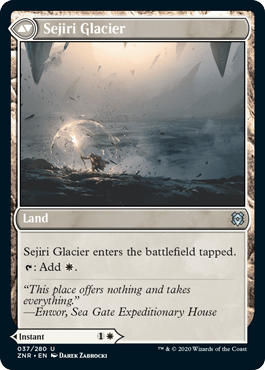
This uncommon from Zendikar Rising does a very good impression of Gods Willing. Sejiri Shelter costs one more mana and doesn’t scry, but it can help keep your land count nice and low in a low-to-the-ground white-based aggro deck that plays things like Leonin Lightscribe. That way you’re more likely to draw into your gas.
#19. Emeria’s Call / Emeria, Shattered Skyclave
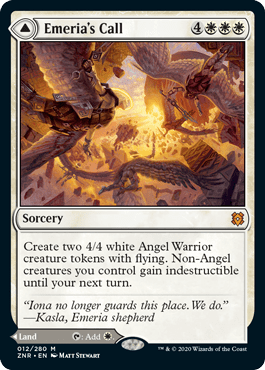
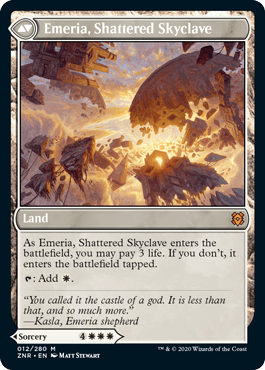
There’s one of these for each color in Zendikar Rising, and they’re all good to great. The back side has the option to come down untapped in a pinch which is huge and shouldn’t be underestimated.
The worst (relatively) is Emeria's Call. All these cards have relatively high casting costs, probably by design, and this one is particularly steep. You get two flying 4/4s out of the deal, and the bonus of your creatures gaining indestructible.
This has seen some play in control decks as a finisher, and probably some angel decks. It’s not quite the staple that some of the others in the cycle are outside of that.
#18. Kazuul’s Fury / Kazuul’s Cliffs
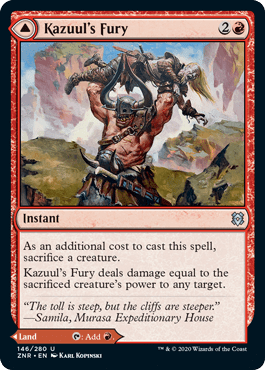

Fling has been a fan favorite for a while now. I know people who get way too excited when it pops up in a Standard set because they can build yet another Fling deck. Kazuul's Fury is the Zendikar Rising’s version of Fling. It costs one more mana but is a land on the other side.
Fling fans can now have two copies in their EDH deck!
#17. Malakir Rebirth / Malakir Mire
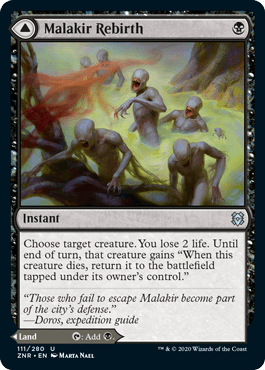
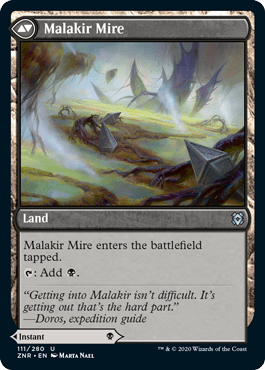
Malakir Rebirth isn’t an over-costed version of an existing card for a change, but it loses you life as you cast it. This is a cool way to balance the card that it keeps it as a 1-mana effect. The 2-life downside is still noticeable, but it’s often more than worth it.
Instead of giving the creature indestructible, the creature dies and comes back. That activates both death and ETB triggers, which could be very useful. Don’t use it on a token, though…
#16. Shatterskull Smashing / Shatterskull, the Hammer Pass
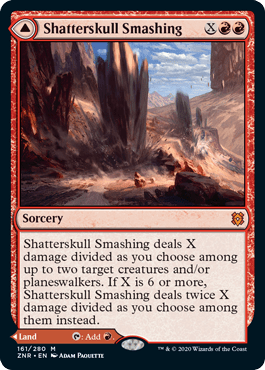
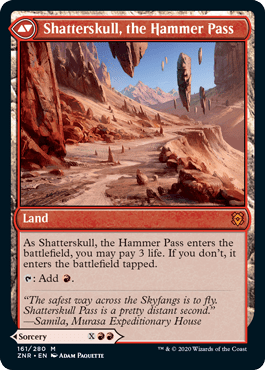
Shatterskull Smashing is another Zendikar Rising mythic. I mentioned that these all come with hefty casting costs, but this one is technically quite cheap. Four mana to deal two damage split up isn’t a great rate, but when it’s good it’s great.
This generally sees play in mono-red, and it’s another case of playing a spell over a land to keep you drawing gas through the game.
#15. Turntimber Symbiosis / Turntimber, Serpentine Wood
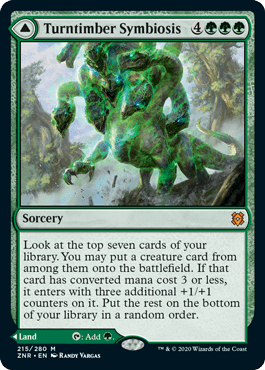
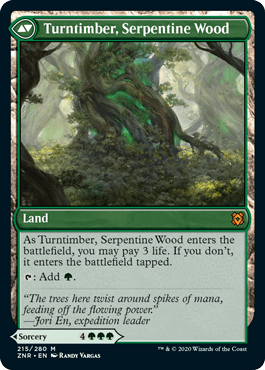
Turntimber Symbiosis is an archetypical big green sorcery. Seven cards are a lot to look at from the top of your deck. If you don’t find your Eldrazi titan in there then your 3-drops comes in beefed up.
It’s a combo-ish piece if you use it to cheat out your chonker, or it’s a toolbox piece if you need to find that specific creature in a sticky situation. It can also just be a land when you need that.
#14. Extus, Oriq Overlord / Awaken the Blood Avatar
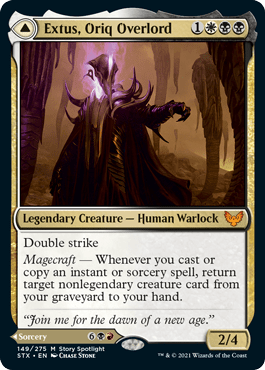
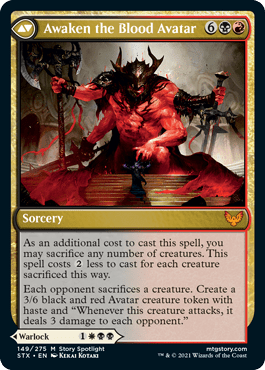
This gets “that’s just kinda cool” points as an MDFC that doesn’t feel at all like a cookie-cutter design. Both sides of Extus, Oriq Overlord seem like cards you wouldn’t be surprised to see in a set, and getting them both together is a great bonus.
I think I’m more interested in the backside here, but it’s close. I love that you can Awaken the Blood Avatar more cheaply in an aristocrats deck and that it can quickly end a 1v1 game. The only gripe about the card is that the two sides want to do different things, but it would probably head up a Mardu () aristocrats EDH deck nicely.
#13. Jwari Disruption / Jwari Ruins

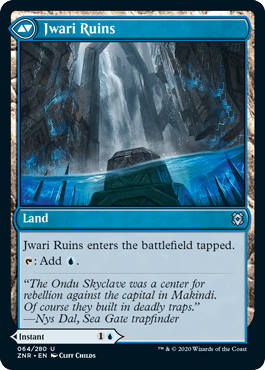
Another of the well-costed spell lands from Zendikar Rising, Jwari Disruption still sees play in blue-based control decks in Pioneer, Historic, and Explorer.
Force Spike has been in and out of the staple realm for years now. This is a 2-mana version that has some use after your opponent uses all their mana. It’s also a nice option for decks that desperately want to hit their land drops.
I don’t see Jwari Disruption going anywhere for a while yet.
#12. Toralf, God of Fury / Toralf’s Hammer
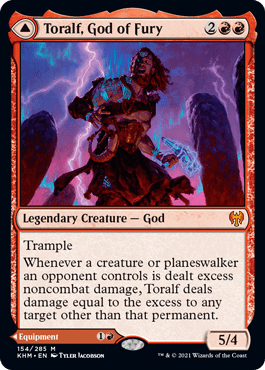
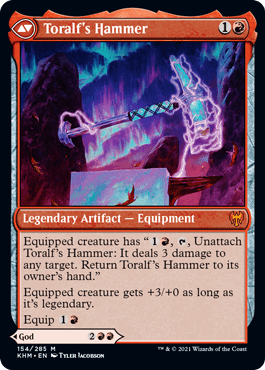
Exploring the design space around excess damage, Toralf, God of Fury is an interesting card. It allows you to use the extra non-combat damage dealt to creatures and planeswalkers to hit anything else, including your opponents’ faces.
Cards like Blasphemous Act can end up being a game-ending card if Toralf, God of Fury is on the board. For each 1/1 that Blasphemous Act hits, you can redirect 12 damage to an opponent. Ouch!
#11. Glasspool Mimic / Glasspool Shore

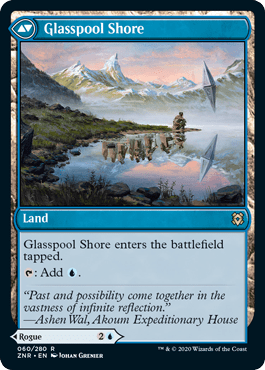
Clone effects are always interesting, particularly when they come at three mana or less. Glasspool Mimic is a strong card on the front half, and the reverse is a bonus!
This card is a combo player's dream. It’s great as part of a combo deck with Dualcaster Mage and Neoform in Constructed formats or paired with many, many cards in EDH and other eternal formats.
#10. Pathway Lands

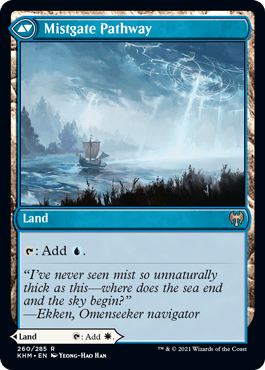

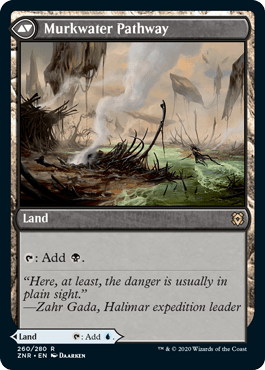
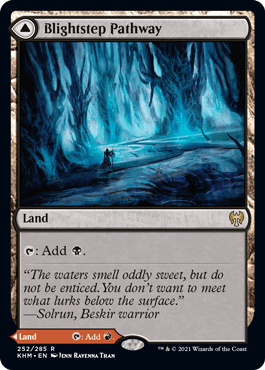







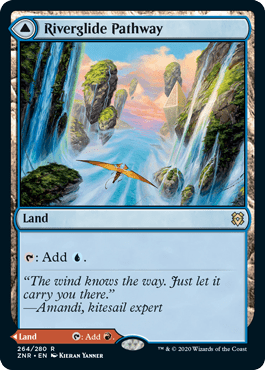
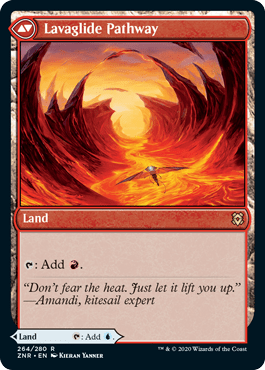

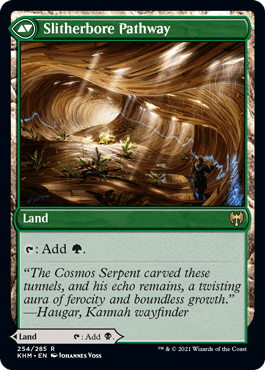
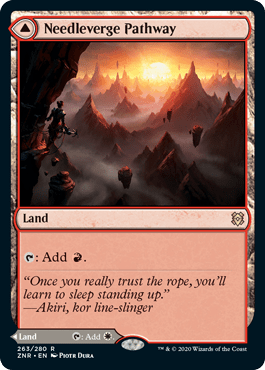
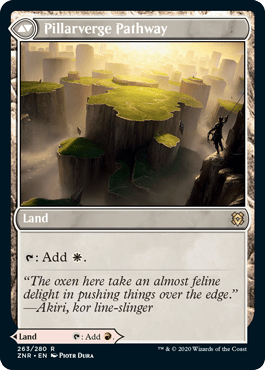
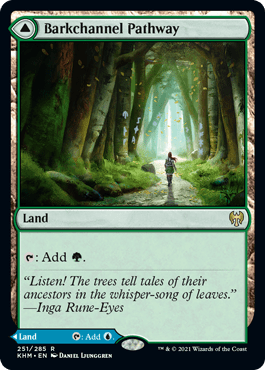

I’m cheating again here by lumping 10 cards in one block. Pathways are the dual lands of the cycle.
They’re pretty good lands in a lot of decks because they come in untapped and give you the option of two different colors of mana when they come down. They’re excellent in most 2-color decks, but they get tough when you get to more colors.
Unfortunately if you want to cast Thoughtseize turn 1 and then Expressive Iteration turn 2, these lands won’t let you do that.
#9. Sea Gate Restoration / Sea Gate Reborn
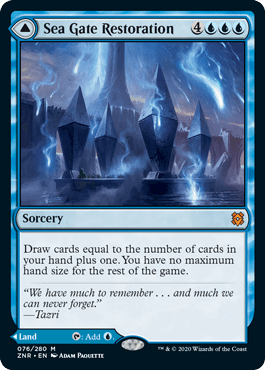

Sea Gate Restoration is a blue player’s dream. If you already have a lot of cards then this just gets you more! What do blue players like more than drawing cards?
Another bonus is allowing you to have no maximum hand size. What’s the point of drawing all those cards if you have to discard them to hand size?
#8. Agadeem’s Awakening / Agadeem, the Undercrypt
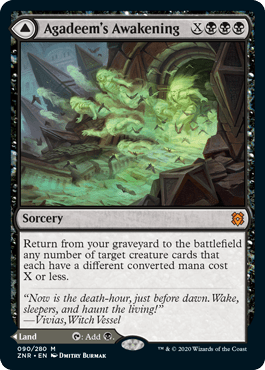
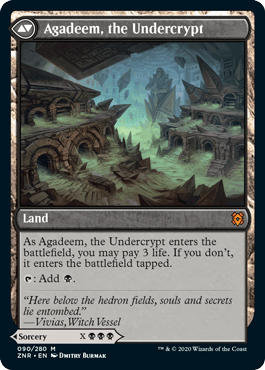
The last of the Zendikar Rising mythic cycle is Agadeem's Awakening. If blue mages like drawing cards, black mages like getting value from their graveyards. This card does just that.
The triple black before paying for X is quite steep, so this is very much in the realm of a late-game card. Once you get to 6+ mana it opens up some pretty sweet combos. I think this is certainly the strongest of the cycle, especially for Commander.
#7. Valakut Awakening / Valakut Stoneforge
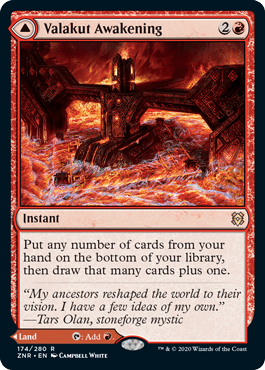
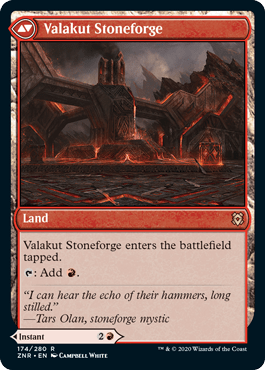
Valakut Awakening is another combo piece, or at least something that can help you get there.
Drawn the wrong half of your deck for your combo? Got too many redundant pieces? No problem, stick them on the bottom of your library and redraw! You can leave your disruption up until your end step, then dig for what you need to go off on your turn.
I think this one is still flying somewhat under the radar.
#6. Tergrid, God of Fright / Tergrid’s Lantern


Do you have too many friends and want to thin them out a little? Tergrid, God of Fright is the commander for you! It’ll get rid of those pesky buddies in no time at all.
As if discard and sacrifice effects weren’t hated enough, you also get to steal the permanents that your opponents discard and sacrifice. What value! The back side, Tergrid's Lantern, goes infinite if you can make infinite mana. But that never happens in Commander, right?
#5. Esika, God of the Tree / The Prismatic Bridge
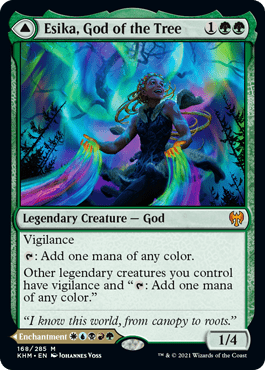

Another commander that can make you a target is one that people hate seeing in Brawl matches on Arena.
Esika, God of the Tree is one of those MDFCs that you care much more about the back than you do the front. One of the many 5-color commanders printed in recent years, this one allows you to cheat out scary threats quickly if you can make all five colors.
This is the most built commander from Kaldheim on EDHRec, and I can definitely see why!
#4. Valki, God of Lies / Tibalt, Cosmic Impostor


Before the rules around cascade were tweaked, Valki, God of Lies was an extremely powerful card. It allowed you to get the planeswalker side down as early at turn 2. But it’s still an incredibly large threat even after this change.
Both sides of this are good, especially in one-on-one formats. The front side is a good hand-hate tool on a stick with some upside. The back side is a game-ending threat that must be answered. Tibalt, Cosmic Impostor creates an emblem that counts everything the planeswalker exiles, even if it’s been removed.
This effect is great for Commander, where when you cast it from your command zone again and again and use the cards exiled earlier in the game.
#3. Birgi, God of Storytelling / Harnfel, Horn of Bounty

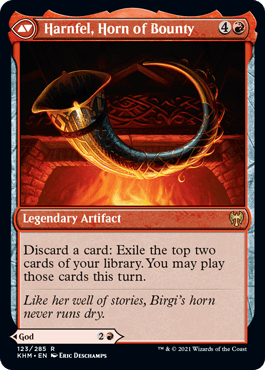
Want a fantastic combo piece that can help you go off out of nowhere? It’s so easy to combo with Birgi, God of Storytelling that it’s almost more difficult to not combo! Aside from its combo potential, the mana that this gives you can generate a lot of value in a red-based midrange deck.
The back side is also great. You can get some especially good value if you already have a Birgi out and can’t cast another because of the legend rule.
#2. Bala Ged Recovery / Bala Ged Sanctuary

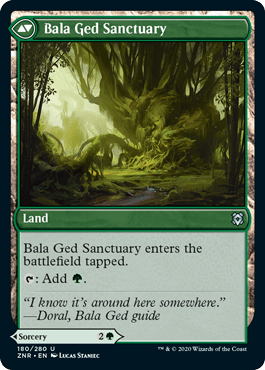
This may seem like an odd choice for one of the strongest card in a world of Tibalts and Esikas, but please stay with me.
Bala Ged Recovery is an effect that pretty much any green deck wants. You can create infinite loops with other cards that get things out of your bin, it can grab your combo piece back… It just provides all the value.
This is the MDFC that I think could legitimately go in any deck. The other top MDFCs are there mainly for their potential to lead a Commander deck rather than be used in the 99. But this innocent-looking uncommon shouldn’t be underestimated. It’s incredibly useful and powerful.
#1. Wandering Archaic
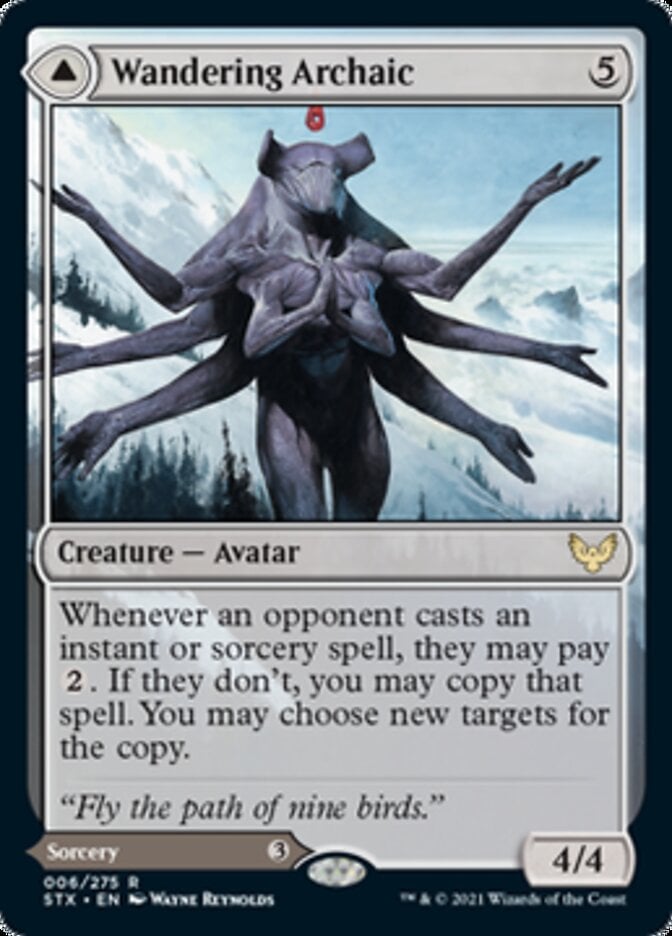
Wandering Archaic is a total bomb in Commander. It puts a 2-mana tax on each of your opponent's instants and sorceries, and if they don't pay it, the consequences are dire. Getting to copy spells not only neutralizes and negative affects they're having on you since you get to do the same to them, or at least threaten to. The flipside is kind of irrelevant. It's a group-hug card that you'll never cast.
Best MDFC Payoffs
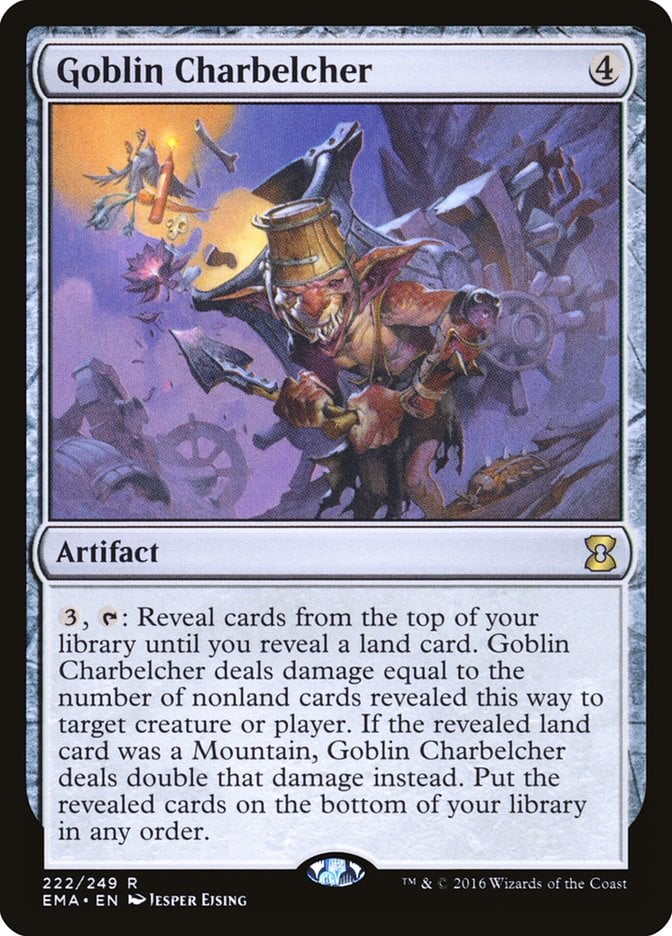
MDFCs don’t have a lot of cards that work specifically with them, at least since the rules around cascade were tweaked. The one deck type that works well with them, specifically the Zendikar Rising MDFCs, is a deck that you don’t want any lands in. I’m looking at you, Goblin Charbelcher.
If you just use the MDFC lands where the land only exists on the back half of the card then it’s classed as the front half type when it’s in your deck (or anywhere else that isn’t the stack or the battlefield). You activate Goblin Charbelcher, reveal your whole deck, then deal a boatload of damage to your opponent.
Is it a glass cannon? Yes. Is it beautiful? Absolutely.
Do MDFCs Count as Lands?
MDFCs only count as lands if they’re on the battlefield with their land side up, or if they have a land on the front face. MDFCs in general only have the properties of their front face everywhere apart from when on the battlefield or the stack.
How Do MDFCs Work in Commander?
If you have an MDFC as your commander you can cast either side from the command zone. Both sides of this MDFC have the same commander tax though, so don’t go trigger happy with the front side of Valki, God of Lies.
The color identity of the card counts both sides of the card. You can have red, black, and white cards in your Extus, Oriq Overlord deck, but you can’t include it in your Teysa Karlov deck.
Can an MDFC Transform? What Happens if it Does?
MDFCs can’t transform. The only cards that can transform are transforming double-faced cards. If an action instructs a player to transform a non-TDFC, nothing happens.
MDFCs vs. Split Cards
MDFCs are basically split cards (like Fire // Ice) that you can fit more words onto. There are a few key differences, like that split cards have the combined mana value and types of both halves, while MDFCs only have the properties of the front half when anywhere other than the stack or the battlefield.
MDFCs are mainly more complex split cards that “only” let you cast one side at a time. Not that that’s a bad thing, of course!
MDFCs vs. TDFCs
TDFCs (like in the Innistrad sets) are different from MDFCs. These cards can’t be played directly on their back face and only transform under specific circumstances on the battlefield.
Wrap Up

Emeria's Call | Illustration by Matt Stewart
MDFCs are a neat way to add some spice and flexibility to your decks. Given Magic’s history with double-faced and split cards, having the option to play a card for one side or the other feels like a natural expansion.
What MDFCs do you like to use in your decks? What would you like to see from this type of card in the future? Let me know in the comments below or over on the Draftsim Twitter.
Catch you on the “flip” side!
Follow Draftsim for awesome articles and set updates: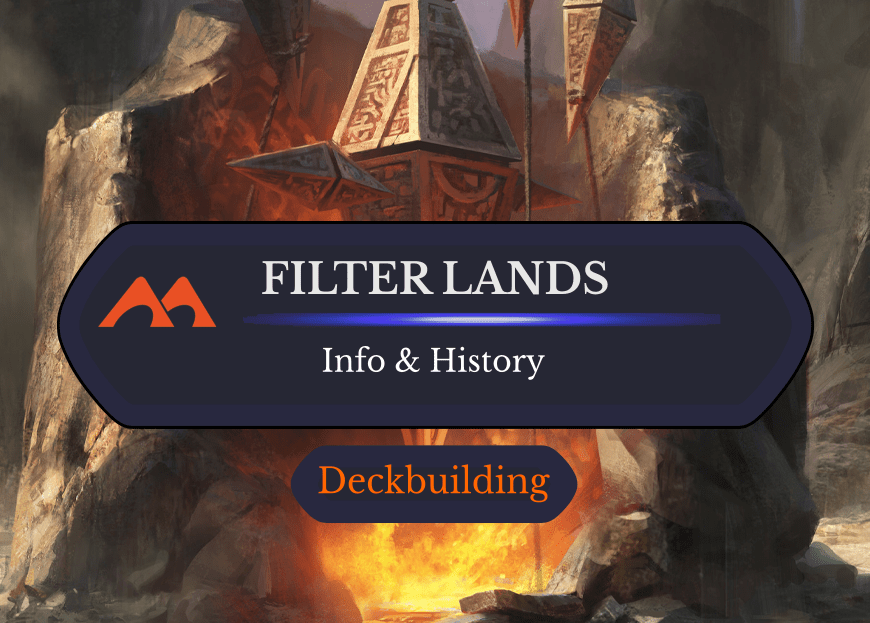
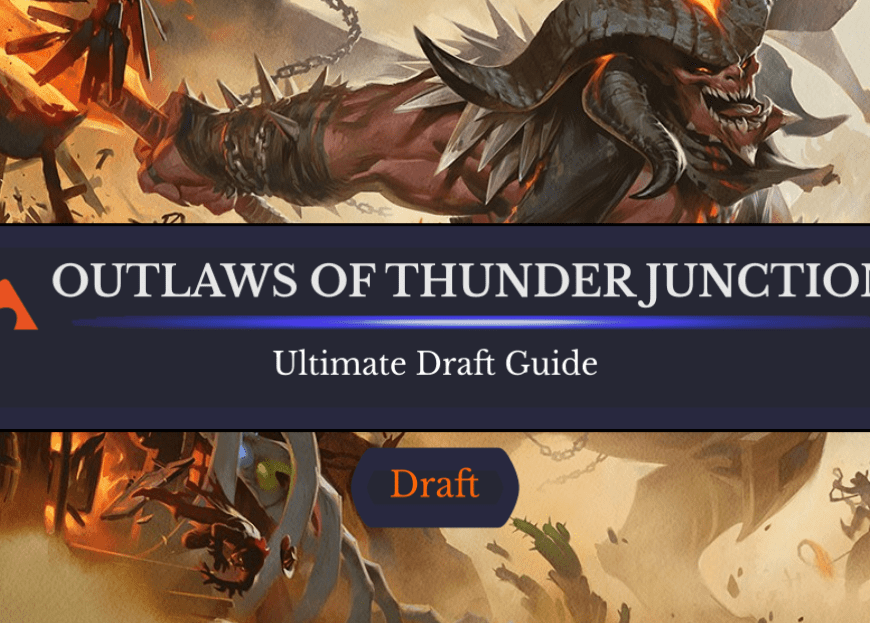
Add Comment